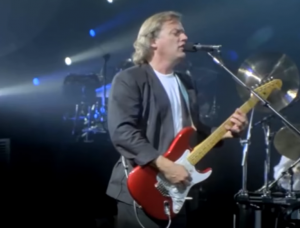One Song That Taught and Inspired David Crosby To Sing

via CBS Sunday Morning / Youtube
Few individuals in 20th-century American music exerted as far-reaching an influence as David Crosby. As a co-founding member of the Byrds, he played a crucial role in shaping the resonant sound of 1960s folk-rock and spearheaded the advent of psychedelic music.
However, his greatest acclaim came as a member of Crosby, Stills & Nash, a supergroup he co-founded with Stephen Stills and Graham Nash, which ushered in the more mature and introspective sound of the 1970s.
Although Byrds frontman and leader McGuinn primarily shaped the band’s signature 12-string guitar sound, Crosby played a pivotal role in crafting their scintillating harmonies. The folk icon attributed his extensive vocal training to years of practice, with one particular band serving as his main vocal mentor.
“This was one of the things that convinced me I really wanted to sing harmony,” Crosby told The Guardian in a 2008 interview, citing the Everly Brothers’ “All I Have to Do is Dream” as the song that inspired him to try vocal blending.
‘[They] wrote the book on harmony singing’
Crosby revealed that he learned both parts of Don and Phil Everly, and he “used to sing along with this record every time it came on”.
“The Everlys wrote the book on harmony singing, which this song epitomizes. It really affected me very strongly and made me want to do it,” The music legend continued.
Much like the artists who inspired him, the songs of The Byrds and CSN(Y) gained so much from the interplay of layered voices, resulting in a spectral presence that enhances the musical backdrop.
Crosby, who died in January 2023, shared with The Guardian 15 years ago some of his favorite songs, which spanned from his childhood to his stints with The Byrds and Crosby, Stills, & Nash. These tracks encompass a wide range of eras, including more recent ones with artists like Death Cab For Cutie and P!nk, as well as the timeless presence of Graham Nash.
View this post on Instagram
Crosby and his love for harmonies
When discussing the origins of his affection for harmonies, Crosby attributed his inspiration to the above-mentioned source that predated The Beatles. Long before John Lennon and Paul McCartney uncovered their knack for harmonies, The Everly Brothers had already created enchanting tributes to love with their exquisite dual vocals, which stood as the most remarkable twin vocal harmonies in the realm of rock music.
In songs like “Bye Bye Love”, Don and Phil Everly seamlessly merged into a single, harmonious voice, rendering endearing hymns to youthful romance that bridged the gap between country and rock and roll.
Written by Boudleaux Bryant of the husband-and-wife songwriting team Felice and Boudleaux Bryant, The Everlys recorded one of their biggest hits, “All I Have to Do is Dream”, in just two takes. When it was released in 1958, the song was the only single to ever simultaneously hit No. 1 on all of the Billboard singles charts.
Crafted by Boudleaux Bryant, a member of the renowned songwriting duo Felice and Boudleaux Bryant, “All I Have to Do is Dream” became one of The Everly Brothers’ major hits, requiring just two takes to record. Upon its release in 1958, this song achieved a unique feat by ascending to the No. 1 position on all of the Billboard singles charts simultaneously.
Harmonious but not really
While Crosby, Stills & Nash (and Young) enjoyed substantial success, the group’s dynamics were marked by volatility, leading its members to explore solo projects and various lineup changes during their peak years in the 1970s.
During this time, Crosby released just one album, the emotionally charged 1971 LP If I Could Remember My Name. He later collaborated with Nash on several records during CSN’s hiatus. Unfortunately, personal issues plagued Crosby throughout the 1980s, culminating in a prison sentence in Texas in 1985.
However, he made a remarkable comeback with Oh Yes I Can, a solo album that arrived 18 years after his debut as a solo artist. It would take another two decades after the release of 1993’s Thousand Roads before he fully committed to his solo career, starting in earnest with Croz in 2014.
Over the subsequent decade, he maintained a consistent output, exploring an elegant, jazzy style of folk-rock inspired by the likes of Steely Dan, Joni Mitchell, and Snarky Puppy. This unique fusion was prominently featured in his smooth 2021 release, For Free.













